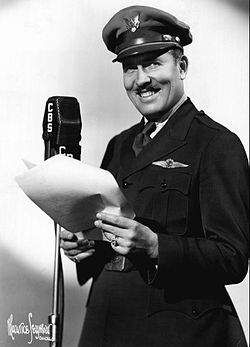Roscoe Turner
| Roscoe Turner | |
|---|---|

Roscoe Turner
|
|
| Born |
September 29, 1895 Corinth, Mississippi USA |
| Died | June 23, 1970 (aged 74) |
| Nationality | American |
| Occupation | Aviator |
| Spouse(s) |
Carline Stovall (m. 1924–46) Margaret Madonna Miller (m. 1946) |
| Parent(s) | Robert Lee Turner Mary Aquilla Derryberry Turner |
| Aviation career | |
| Known for | Barnstorming; Air racing; pet lion |
| Famous flights | Transcontinental airspeed record New York to Los Angeles (1930, 1932); Transcontinental airspeed record Los Angeles to New York (1933); MacRobertson Air Race (1934); Bendix Trophy (1933); Thompson Trophy (1934, 1938, 1939) |
| Awards | Harmon Trophy (1933, 1939); Distinguished Flying Cross (1952); National Aviation Hall of Fame (1975); Motorsports Hall of Fame of America (1991) |
Roscoe Turner (September 29, 1895 – June 23, 1970) was a record-breaking American aviator who was a three-time winner of the Thompson Trophy air race, and widely recognized by his flamboyant style and his pet lion.
Roscoe Turner was born in Corinth, Mississippi, the eldest son of farmer Robert Lee Turner and his wife Mary Aquilla Derryberry Turner. From 1903 to 1910, he attended the Glover school in West Corinth, and his formal education reached the tenth grade, the highest available there. He came to realize that he did not want to be a farmer, and daydreamed of a future on the railroad that ran through the family farm. He developed interests and skills in repairing, constructing and experimenting with mechanical objects, including horse-drawn wagons, large kites, motorcycles, and eventually, automobiles. He studied at business college for about six months, then worked in a hardware store, and briefly at a local bank, in the occupation then preferred by his father.
At age 16, he moved to Memphis in the hope of being an automobile mechanic, but had to take a job as a dispatch clerk. A truck driver befriended him, helping him with driving and navigating the local area, allowing him to gain employment as a driver. He attributed his success at interview to meticulous preparation of his clothing and appearance, an ethos that characterized the rest of his life. He then worked at various jobs, including automobile mechanic, chauffeur and salesman, often coincidentally. He first saw an aircraft in 1913, and in 1916 decided to become a pilot. He applied to the Army for flying training, but despite having mechanical expertise and driving experience, he lacked the required college education.
After America entered World War I in April 1917, he enlisted as an ambulance driver. Within months, he was promoted from private to sergeant first class. In January 1918 he was accepted as a Flying Cadet and trained as a balloon pilot. In March 1918, he was commissioned as a second lieutenant in the Signal Corps Reserve. In September 1918, he departed the US to serve in France and Germany, where he gained some unofficial flying training in fixed wing aircraft. In July 1919, he returned to the US as a First Lieutenant, and was discharged in September 1919.
In October 1919, Turner went into partnership with Harry J. Runser, who had already been barnstorming with a Canuck biplane, a Canadian version of the Curtiss JN-4 Jenny, and who needed someone to act as mechanic, wing-walker and parachutist. Together, they toured eastern and southern states with their passenger joyriding flights and displays of stunts that included posed aircraft crashes. They wore Army–style uniforms, and Turner developed his own design of tailor-made uniform of blue tunic, fawn jodhpurs, riding boots and a beige officer cap. He added a silver winged brooch and a fancy belt, and grew a waxed mustache to accentuate his toothy smile. In later life, he maintained that his carefully contrived appearance was both practical and good for business, but that he grew to dislike wearing the uniform.
...
Wikipedia
